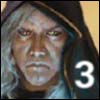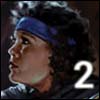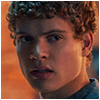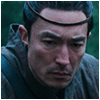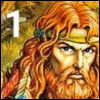I found this re-read to be quite interesting. I'm always excited thinking about the story and the world and the nostalgia it brings, but when I actually start reading...I struggle to keep my focus half the time. While this first book was more enjoyable than any of The Apprentice Adept books, it's still subpar for my tastes in this day and age. Some parts shine, while others drag it all down. That dragging kept me from getting this first blog entry up in a decent amount of time.
The writing is generally okay, but suffers from slippery points of view and too much telling / info dumps. And some of the battle sequences clearly feel turn-based and lifted from a Dungeons & Dragons gaming session (which of course, many are). Just like much of the other fantasy I read as a teenager, it's basically equivalent to today's Young Adult (YA) fantasy, except the subject matter isn't about dystopian societies or not fitting in.
Before You Continue
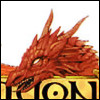
- This blog is part of my Dragonlance Retrospective
- See this blog post for an overview of the Retrospective
- These blogs are not plot recaps—they are most effective in conjunction with your own re-read of the series
- Warning: CONTAINS SPOILERS FOR THE ENTIRE SERIES
What it is
The series is essentially a mash-up of Lord of the Rings and David Eddings' The Belgariad and The Malloreon. You get all the high fantasy trappings of a multi-class/racial party that jokes around with each other combined with a serious quest to save the world. Yet Lord of the Rings does the races and lore better, while David Eddings did the "bantering companions on a quest" better. Middle-earth feels real, with a plausible history. Garion and Belgarath and Silk and all of them feel like family and are simply fun to read about.
As for Dragonlance, it's kinda half of both, with neither half completely succeeding. Some characters really standout (Tanis and Raistlin), while others are generic caricatures (Caramon and Flint). They add interesting new races, while the traditional elves and dwarves are ho-hum and not much different than what Tolkien did.
There are some rousing, original action scenes (Xak Tsaroth is the highlight for me), but it frequently reuses fantasy staples from other works. Like the mysterious Darken Wood no one wants to enter (Fangorn Forest in Lord of the Rings), or the Sla-Mori (Doors of Durin in Lord of the Rings), or the founding of a sword in the tomb of a dead king (Conan the Barbarian anyone?)...I could go on. They are enjoyable in their own way, but if you're a big fan of fantasy like myself, they're nothing new.
How it Differs
Weis & Hickman made the world of Krynn unique in a few ways. They have an additional race called kender, that are basically adult children with elven ears who are super curious and have no fear. They get into trouble a lot, provide much of the comic relief in the story, and tend to serve as characters who never lose their sense of wonder about the world.
Another differentiator is the race of draconians, human-like lizards that die in strange ways. For example, one type of draconian (Baaz) turns to stone after it dies, so if you stabbed it with a sword...it's stuck in the stone corpse until it crumbles to dust. Another type (Kapak) turns into a puddle of acid. Not good in the heat of battle.
(I remember playing the Champions of Krynn computer game back in the early 90s, and the draconians that explode upon dying (Bozak) were always super annoying.)
The concept of magic is slightly different too, stemming from the design of the campaign world for Dungeons & Dragons. Magic users have an "alignment"—for example, you are either a good, neutral, or evil wizard or cleric. These powers wax and wane according to the three moons of Krynn: Solinari (silver moon), Lunitari (red moon), and Nuitari (black moon), respectively.
Who's Narrating?
Something that was quite jarring for me that I totally forgot about over the years: the use of the third-person omniscient point of view throughout the book.
Usually with strict third-person, there's a scene or chapter break to indicate that you are shifting to someone else. But in this book, the authors abruptly shift perspective from one character to another, with the reader privy to each of their thoughts. This sometimes happens from paragraph to paragraph, and can be hard to follow.
This is not a writing style I personally like to employ, due to the potential confusion it can cause readers. And really, you shouldn't need to use third-person omniscient ever. If there's something important in each character's thoughts that the reader needs to know that requires use of third-person omniscient...well then I think the story should be written a different way. Or quickly switch between characters with scene breaks. It's not hard to do.
For example, in my The Hope of Memory trilogy, there are four different POV characters, and some events are told multiple times, from more than one viewpoint character. It provides a greater impact, done the right way, in my opinion.
The Cover

Quick aside for the cover, a Brad Murgen Retrospective Tradition.
There have been a few different versions of covers for this series, but they are all essentially the same: a few of the characters standing around with a dragon lurking in the background.
I'm partial to the original version, since that's what I have. Unfortunately I couldn't find a better complete image online, so you get the Wikimedia one.
It's painted by Larry Elmore, a titan of fantasy illustration, and features Tanis, Goldmoon, and Sturm. So not too exciting, and not a scene from the actual book, but it's at least somewhat accurate in its depiction of the characters. My only nit is that I feel Goldmoon should look more tribal. Just adding some fur fringe doesn't do it for me.
The Wertzone has a much higher resolution version of the painting by itself, if you're so inclined.
Shades of Red
Okay, the thing that I liked the most: Raistlin.
He's by far the most interesting and memorable character in the book, because of his ambiguity. He vacillates between helping the group and being selfish. He's a red mage here—neutral—and it shows. Which makes for an interesting read.
Weis & Hickman do a great job showing you that Raistlin really is selfish at the core, he's interested in power more than anything else...yet his good side pops up at random times for the benefit of the group. It's hard not to like him when the gully dwarves follow him around like puppies. And his whispering and always being sick are classic traits that stick with you. It's the thing that stands out the most in the book.
His twin brother, Caramon, however—the dumb-as-a-doornail stereotypical warrior. The Legends trilogy focuses on Raistlin and Caramon, so hopefully Caramon is as bearable as I remember him to be. Because I'll have to read six books worth of him.
Shades of Human
The thing I liked the second most is Tanis Half-Elven. His half-elven nature is also ambiguous, and it's interesting because he embraces the human side more than the elven (growing a beard and using his human name). There have been half-elves in fantasy fiction before (Aragorn in Lord of the Rings, Shea Ohmsford in The Sword of Shannara), but I feel like Tanis was the first time an author really got the conflict between the human and elven sides right.
Tanis's heart is pulled in two directions, another facet of the internal human vs elf battle. He has a childhood sweetheart named Laurana, an elven beauty who still loves him, and who tags along halfway through the book to prove her worth. But Tanis also has an adult sweetheart named Kitiara (the half-sister of the twins Raistlin and Caramon), and he's convinced he loves her, but has doubts because she didn't show up for the reunion of the companions at the beginning of the book.
Kitiara doesn't make an appearance until the next book. Her absence makes for an interesting setup, though, and with Raistlin's ambiguity, is one of the hallmarks that drives the series. More on that in the next blog.
The Illustrations
Oh and another thing I like! Each chapter has a little illustration, and instead of a chapter title, uses a few short phrases to describe what's coming. It's a nice touch that seems to only be done for YA books these days (further reinforcing my idea that this is YA fiction before there was a YA section). Harry Potter comes to mind...I love the illustrations they have for each chapter.
Here are my favorite two from this book:
As you can see, the illustrations are super awesome. They're in all the books (though the Legends trilogy did away with the phrases, boo) and are drawn by Valerie Valusek, who did a lot of illustrations for TSR in their heyday. I did a search and it doesn't seem that she has much of an online presence, and wants to keep it that way, so I won't make a fuss. A Google Image search brings up a lot of examples of her work, do one sometime.
For each book in this Retrospective I'll post my two favorites. They do a lot to set the mood and feel of the world, and I can't imagine the books without them.
Fizban
So I have to call out this character...the stereotypical "old wizard." I honestly don't like this character at all. I didn't back when I was a teenager, and I still don't now. He feels completely out of place, and adds too much of a "Get Out of Jail Free" card-ness to the story. I know it's supposed to be "fun" fantasy, but Fizban goes a little too far. He's too goofy compared to every one else (even Tasselhoff Burrfoot, our lovable kender).
Now, there's obviously more to Fizban than meets the eye, and it took me a while to remember exactly who he was. We'll talk more about him in the future. That doesn't excuse the implementation of the character here, though.
What's also annoying about Fizban, is that Weis & Hickman also use him in their Death Gate Cycle series (going by the name of Zifnab, to avoid copyright issues since TSR owned the Fizban character). If I ever do a Retrospective on that series, I'm sure I'll have a few choice words about that. They might have even used him in some of their other work. I don't know, since I haven't read much of anything else by them.
Regardless, if you're going to have characters cross worlds, or pretend to be something they're not, at least make it believable and not so obvious.
The Story
I haven't really talked about the story yet, huh. We'll get more into that during the other blog posts, but you should know by now that I don't like to simply recap things. You can read it for yourself. (TV recaps that literally recap the events without adding anything new drive me nuts.)
The story begins as standard fantasy fare. Some new evil has arisen in the land and our companions unite to try to figure out what. They visit a ruined city and rediscover some of the magic that disappeared when the gods turned away from Krynn after the Cataclysm. They see dragons for the first time in forever, travel back and forth across the same small section of land, meet up with some elves, and have another big confrontation with dragons and the Highlords that ride them in another city. Oh, and there's a dude with a green gemstone lodged in his chest.
There's plenty to wonder about. How big is this world of Krynn? What's up with the constellations disappearing? Who are the Dragon Highlords? What are Dragonlances? What's the Cataclysm all about? Who is Fizban really? What's up with the Green Gemstone Man? Why is Raistlin obsessed with Fistandantilus? Where is Kitiara?
And hey Brad, what about all the other characters you didn't even mention like Flint, Tasslehoff, Goldmoon, Riverwind, Tika, Gilthanas, Verminaard, Fewmaster Toede, Bupu...?
Stay tuned! I'm sure I'll have more to say about them later.
The Movie

Oh, and I can't forget to mention the animated movie they did of this book! It was released direct-to-video back in 2008, with Raistlin voiced by Keifer Sutherland. Lucy Lawless (of Xena: Warrior Princess fame) voiced Goldmoon.
I have a copy of it and watched it some years ago...but honestly all I can remember was that it wasn't very good, and it generally got panned. They shoved the entire book (which is a fairly decent size, 450 pages) into a single 90 minute movie, which obviously is not easy to do well.
You can read more about it on Wikipedia and IMDB.
However, I just discovered today that a live-action version might be in the works?
Dragonlance Chronicles / Legends
Next
2020-06-29 Dragonlance: Chronicles [2] Dragons of Winter Night (1985)
Previous
2017-09-03 Dragonlance: Chronicles / Legends - The Retrospective
